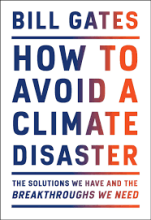How we plug in - Making Carbon-Free Electricity
12 important questions on How we plug in - Making Carbon-Free Electricity
What is the main advantage of nuclear power?
- It's the only carbon-free energy source that can reliably deliver power day and night, through every season, almost anywhere on the earth, that has been proven to work on a large scale.
- The U.S gets 20% and France 70% of its electricity from nuclear power.
The Massachusetts Institute of Technology analyzed in 2018 1,000 scenarios for getting to zero in the U.S, what did they found?
- They investigated the cheapest paths involved using a power source that's clean and always available - like nuclear power - but, without a source like that, it would cost a lot of money to get to zero.
It's not a secret that nuclear power isn't ideal, because it has problems. About what problems speaks Bill Gates?
- It's very expensive to build today
- Human error can cause accidents
- The fuel it uses, can be converted for use in weapons.
- The waste is dangerous and hard to store.
- Higher grades + faster learning
- Never study anything twice
- 100% sure, 100% understanding
Another approach to nuclear power is nuclear fusion. What does this mean?
- Instead of getting energy by splitting atoms apart, as fission does, it involves pushing them together, or fusing them.
What is an advantage of using nuclear fusion?
- It would run on commonly available elements, making the fuel cheap and plentiful.
- Tot indicate this; the main type of hydrogen can be extracted from seawater and the fusion's waste products would be radioactive for hundreds of years.
Can you explain why nuclear fusion is very hard to use?
- It takes so much energy to kick off the fusion reaction that you often end up puttting more into the process than you get out if it.
- It's a huge engineering challenge to build a reactor, becuase none of the existing fusion reactors are designed to produce electricity that consumers could use.
One of the projects that are still under construction, a collaboration between six countries and the European Union (EU), is an experimental facility in southern France known as ITER. What expectations are there for this project?
- The project started in 2010, and by mid-2020s it's expected to generate its first plasma, and to generate excess power - 10 times more than it needs to operate - in the late 2030s.
What advantages does the installation of wind turbines in an ocean have?
- Many major cities are near the cost, so we can generate electricity much closer to the places where it'll be used and not run into as many transmission problems.
- Offshore winds generally blow more steadily, so intermittency is less of an issue too.
How much capacity for generating electricity has the offshore wind?
- 0.4% in 2019 and most of that is in Europe.
- The U.S has 30 megawatts installed and America uses around 11,000 gigatwatts.
How can geothermal generate carbon-free electricity?
- Deep underground, there are rocks than can be used to generate carbon-free electricity.
- We can pump water at high pressure down into the rocks, where it abosrbs the heat and then comes out another hole, where it turns a turbine or generates electricity some other way.
How much is the energy desity of geothermal - the amount of energy we get per square meter - according to David MacKay?
- This is quite low; according to David MacKay (2009) geothermal could meet less than 2% of the U.K energy needs.
What are two disadvantages of geothermal energy production?
- Only 40% of all wells dug for geothermal can't use for electricity, and it's hard to know ahead if the dug is going to produce the heat.
- Geothermal is only available in certain places; areas with aboveaverage volcanic activity.
The question on the page originate from the summary of the following study material:
- A unique study and practice tool
- Never study anything twice again
- Get the grades you hope for
- 100% sure, 100% understanding
































